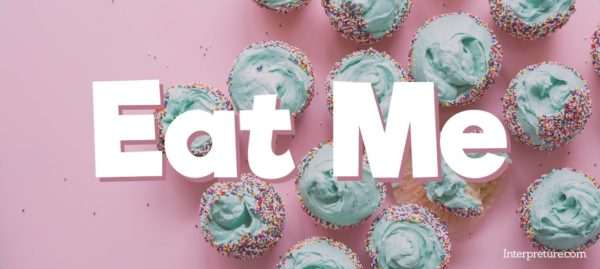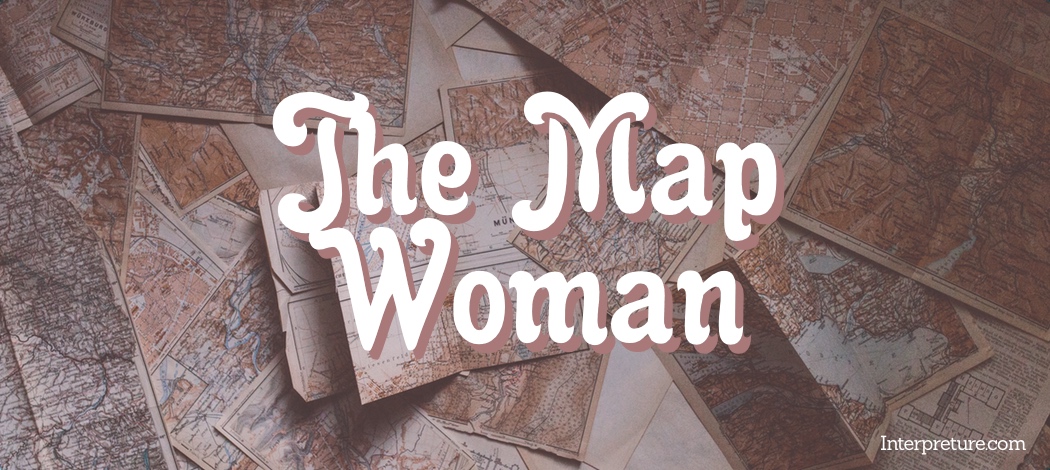‘Eat Me’ is a poem by Patience Agbabi which looks at the idea of a ‘feeder’ role within a relationship, using an unusual structure of tercet stanzas and a notable semantic field. Agbabi is a performance poet with Nigerian ancestry, who was born in London, and fostered by a Welsh family. Her work often focuses on the idea of an outsider or differences between people, which is evident in ‘Eat Me’, with key themes including Transgression and Taboo, Power, and Gender. In 2017 she was elected as a Fellow at the Royal Society of Literature, with past and present members including Samuel Taylor Coleridge and J.K. Rowling.
This poem is part of the set of prescribed poems that could be included in the Edexcel English Literature exam, meaning that it is important to study, understand and revise this poem. Click here to see all the prescribed poems from the ‘Poems of the Decade’ collection.

Interpreture gives ‘Eat Me’ a difficulty rating of 3, meaning that it is deemed to be of average difficulty. The difficulty is spread relatively evenly throughout the different aspects of the poem, with the potential of challenging techniques being partially outweighed by the variety of devices, making analysis relatively easy in an exam situation.
‘Eat Me’
The title is relatively ambiguous at first, however it can still offer a variety of interpretations. Firstly, it is typically stylised in capital letters, which can be seen as signifying the growth of the woman throughout the poem as a result of the constant feeding. While there can be a physical interpretation, there is also the notable metaphysical interpretation with the idea that the man is mentally devouring her spirituality. It is also interesting to consider the way that the narrator could be seen as encouraging this behaviour with the use of “me”.

Poem Structure
The very rigid form of the poem helps to represent the strict regime imposed by the feeder, and how it has become commonplace. There are a total of ten tercet stanzas, which adds to the overall regimented mood. In addition, there is assonance between the final words on the first and third lines of each stanza, such as “cake” and “weight”, with an alternative form of assonance in each line which breaks from the traditional idea of using rhyme. This is a very interesting rhyme scheme for a reader because it enables variety of language while still maintaining a sense of conformity and expectations, potentially echoing the expectations of the feeder.
Even more interesting is the use of consonance on each corresponding line, for example the first line of each stanza has the “k” sound, “d” on the second and “t” on the third. The only point in which this is broken in the poem is at the end of stanza six, but even this is largely negated by the fact that the next word is “too” so therefore continues the overall consonance. These strong sounds once again evoke ideas of force and control, showing how important this is to the poem.
There are also consistent end-stopped lines on the final line of each stanza (although again with the exception of stanza six), which reinforce the idea of routine and consistency. However, there is also a slight break in this structure too with the final two lines of the last stanza both ending with full stops, which signifies the death of the man, and by extension, the relationship. This helps to make the poem more dramatic, and also bring a sense of unease to the reader through the way in which the expected pattern and rhythm has been disrupted.
Poetic Techniques
Various poetic devices are used throughout ‘Eat Me’, one of the more common ones being alliteration. A key example is “bigger the better” and “broad belly wobble”, both of which help to reaffirm the idea of obesity and being overweight, and even have a ‘wobbly’ nature to the sound. This is further emphasised through the repetition of ‘fat’ throughout the poem, helping to ensure that this idea is never far from the reader’s thoughts, particularly in the seventh stanza. The forceful yet resentful tone of this stanza is particularly noticeable because of the way that the pace is increased.
There is also the use of possessive language, such as “his” or even further objectification through the likening to objects, such as “his jacuzzi”. This would help to make the descriptions much more emotive for a reader who would recognise the strong objectification and mistreatment, therefore developing much more sympathy for the narrator. This in turn creates a strange mix of emotions by the end of the poem with the murder of the feeder, with readers potentially feeling happy that the woman has been freed but conflicted over the means of this escape.
Ideas and imagery regarding water and oceans are also commonplace throughout the poem, with the semantic field including examples such as “shipwreck” “beached whale” and “tidal wave of flesh”. This is a very effective technique because it connects the idea of fat and cellulite with oceans and waves, and through their association with expanse and depth helps to show how overweight the woman has become. It also can be interpreted as representing a ‘hidden’ power which the woman has, and isn’t appreciated by the man until he is “drowned” at the end of the poem.
Important Lines
“I like big girls, soft girls”
The objectification in this line shows how much the man is using the woman for his pleasure, not for hers. The only focus is on what he wants and likes, without any regard for the woman. The repetition of “girls” can also be seen as patronising the woman, and can also be seen as showing her vulnerability by likening her more to a child than to an adult.
“my only pleasure the rush of fast food”
By emphasising the “rush”, it is clear that any pleasure the woman receives is short lived, with all the focus being on the man and with her needs not fully catered for. The alliteration of “fast food” helps to show the importance of this line to the poem, and also shows how unhealthy this relationship is, both in terms of the physical food being eaten and the mental appreciation between the two. Some may also interpret the line as representing an unhealthy addiction, both to the food and to the relationship.
“There was nothing else left in the house to eat.”
‘Eat Me’ ends on an ambiguous, and arguably sinister, line. There is a strong sense of uncertainty, as the feeder has now made the ultimate sacrifice of himself in order to feed the woman, most likely through the idea of consumption rather than actual cannibalism. It also marks the point at which the woman now has to provide for herself, and raises questions for the reader such as whether she will now be able to have a healthy relationship or lifestyle without being overfed.
‘Eat Me’ Key Themes
- Power: Throughout ‘Eat Me’ the idea of power is very important because it is fundamental to the ‘feeder’ relationship. Without this power it wouldn’t be able to operate, and the objectification and possession would not be able to take place.
- Gender: This is very important to the poem and focusses on the idea of a man overpowering a woman in order to continue with his control over her, however this is reversed by the end of the poem. Also, the discussion of the idea of body imagery is solely based on the female rather than the male, which can be seen as reflecting the stereotypical societal attitude towards this subject.
- Transgression and Taboo: The idea of a ‘feeder’ role within a relationship is very much linked to sexual ideas, and that someone could have strong control over another person’s life. This isn’t talked about much within society and is typically avoided due to people’s discomfort with discussing things of this nature. There is also the idea of discussion of the female body, particularly in this rather grotesque way.
Quick Focus Questions
- How does the structure of the poem help communicate meaning to a reader?
- In what ways is the idea and theme of power presented?
- How effective is Agbabi’s use of imagery, specifically in relation to the way in which size and scale are described? Consider the impact on a reader.
‘Eat Me’ is a very interesting poem with its wide variety of techniques, and also forms many interesting links with others in the ‘Poems of the Decade’ collection. For example, the strict structure can be likened to ‘Look We Have Coming to Dover!’ along with the idea of waves and water, or the theme of transgression with ‘The Lammas Hireling’ or ‘The Deliverer’. The ambiguous ending also helps to make the poem more interesting due to the potential for various interpretations, also helping to identify links and contrasts; particularly for evaluative points.







13 Comments
This is very useful! Thank you so much!
This was really helpful however I wanted to know. What poems can you compare ‘Eat Me’ one to?
‘Eat Me’ is a great poem to use for comparison due to its range of themes and ideas. As a starting point you could compare the idea of transgression with ‘The Lammas Hireling’, ‘The Deliverer’ or ‘Giuseppe’, the structural ideas with ‘Look We Have Coming to Dover!’ or the ways power is shown with ‘A Minor Role’ or ‘On Her Blindness’.
I think I totally agree with this point, Alex.’
It does create somewhat of a solemn tone when using “I was his Jacuzzi”
Chainsaw versus the pampas grass is a good one. Both explore male dominance and the female overall victory and courage
This response utterly ignores the sexual angle of this poem. The penultimate tercet is a basically quite degrading sex act where the dominant man questions her abilty – physically – to have intercourse with him, with her on top.
Our analysis is always designed to be a starting point for students. There’s definitely a range of opportunities to consider and analyse the sexual aspects of the poem, although this is a more challenging theme to find comparisons for across the ‘Poems of the Decade’ collection.
What are the tones?
The tone of Eat Me is really interesting and I think surprisingly complex. On one hand you have quite a matter-of-fact description from the narrator (eg. “I was his Jacuzzi”), which arguably could be seen as contributing to an indifferent, almost solemn tone. That’s quite interesting to consider, because for all that is being described you would perhaps anticipate an angry or resentful tone, which I don’t really think this is present.
You also have the contrast of the speech from the man (also emphasised in italics) which is quite sinister, exploitative. For readers who have ever been in negative relationships I think this would be extremely effective. The ending is also relatively sinister, yet because it’s lacking in any particular emotions it still feels very different to the tone of the man’s speech.
thanks!
I think it is also interesting to look at the motif of time in the poem.
Thank You so much for the analysis. It is thorough and insightful and was definitely a great help in improving my understanding of the poem as a whole!
This poem was amazing!
‘Eat me’ was kind of moving and sombre too.
It really emphasises the fact that even though men can seize patriarchal power, women can fight back and change the views of how they are seen.
Patience Agbabi you have hit the point on conveying the meaning of this poem.
Yaaaaaaaaaaaaaas! :)